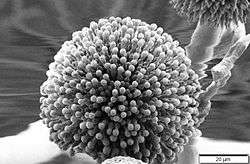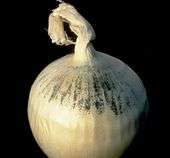Aspergillus niger
| Aspergillus niger | |
|---|---|
 | |
| Micrograph of A. niger grown on Sabouraud agar. | |
 | |
| Details of the head | |
| Scientific classification | |
| Domain: | Eukaryota |
| Kingdom: | Fungi |
| Phylum: | Ascomycota |
| Subphylum: | Pezizomycotina |
| Class: | Eurotiomycetes |
| Order: | Eurotiales |
| Family: | Trichocomaceae |
| Genus: | Aspergillus |
| Species: | A. niger |
| Binomial name | |
| Aspergillus niger van Tieghem 1867 | |
| Synonyms | |
|
Aspergillus niger var. niger | |
Aspergillus niger or A. niger is a fungus and one of the most common species of the genus Aspergillus.
It causes a disease called black mould on certain fruits and vegetables such as grapes, apricots, onions, and peanuts, and is a common contaminant of food. It is ubiquitous in soil and is commonly reported from indoor environments, where its black colonies can be confused with those of Stachybotrys (species of which have also been called "black mould").[1]
Some strains of A. niger have been reported to produce potent mycotoxins called ochratoxins;[2] other sources disagree, claiming this report is based upon misidentification of the fungal species. Recent evidence suggests some true A. niger strains do produce ochratoxin A.[1][3] It also produces the isoflavone orobol.
Taxonomy
A. niger is included in Aspergillus subgenus Circumdati, section Nigri. The section Nigri includes 15 related black-spored species that may be confused with A. niger, including A. tubingensis, A. foetidus, A. carbonarius, and A. awamori.[4][5] A number of morphologically similar species were recently described by Samson et al.[5]
Recently the strain of ATCC 16404 Aspergillus niger has been reclassified at Aspergillus brasiliensis (refer to publication by Varga et al.[6]). This has required an update to the U.S. Pharmacopoeia and the European Pharmacopoeia which commonly use this strain throughout the pharmaceutical industry.
Pathogenicity
Plant disease

A. niger causes black mold of onions and ornamental plants. Infection of onion seedlings by A. niger can become systemic, manifesting only when conditions are conducive. A. niger causes a common postharvest disease of onions, in which the black conidia can be observed between the scales of the bulb. The fungus also causes disease in peanuts and in grapes.
Human and animal disease
A. niger is less likely to cause human disease than some other Aspergillus species. In extremely rare instances, humans may become ill, but this is due to a serious lung disease, aspergillosis, that can occur. Aspergillosis is, in particular, frequent among horticultural workers who inhale peat dust, which can be rich in Aspergillus spores. It has been found in the mummies of ancient Egyptian tombs and can be inhaled when they are disturbed.[7]
A. niger is one of the most common causes of otomycosis (fungal ear infections), which can cause pain, temporary hearing loss, and, in severe cases, damage to the ear canal and tympanic membrane.
Industrial uses
A. niger is cultured for the industrial production of many substances. Various strains of A. niger are used in the industrial preparation of citric acid (E330) and gluconic acid (E574) and have been assessed as acceptable for daily intake by the World Health Organisation. A. niger fermentation is "generally recognized as safe" (GRAS) by the United States Food and Drug Administration under the Federal Food, Drug, and Cosmetic Act.[8]
Many useful enzymes are produced using industrial fermentation of A. niger. For example, A. niger glucoamylase is used in the production of high fructose corn syrup, and pectinases are used in cider and wine clarification. Alpha-galactosidase, an enzyme that breaks down certain complex sugars, is a component of Beano and other products that decrease flatulence. Another use for A. niger within the biotechnology industry is in the production of magnetic isotope-containing variants of biological macromolecules for NMR analysis.
A. niger growing from gold mining solution contained cyano metal complexes, such as gold, silver, copper, iron, and zinc. The fungus also plays a role in the solubilization of heavy metal sulfides.[9] Alkali-treated A. niger binds to silver to 10% of dry weight. Silver biosorbtion occurs via stoichiometric exchange with Ca(II) and Mg(II) of the sorbent.
Other uses
A. niger is the main agent in the fermentation of Pu-erh tea,[10] the Okinawan awamori spirit, and some varieties of shochu.[11]
In 2006, it was reported that a secreted RNase produced by A. niger called actibind has antiangiogenic and anticarcinogenic characteristics.
A. niger is also cultured for the extraction of the enzymes glucose oxidase (GO) and Alpha-galactosidase (AGS). Glucose oxidase is used in the design of glucose biosensors, due to its high affinity for β-D-glucose.[12][13] Alpha-galactosidase can be produced by A. niger fermentation; it is used to hydrolyze alpha 1-6 bonds found in melibiose, raffinose, and stachyose.
Research published in 2006–2008 investigated A. niger prolyl endoprotease (AN-PEP), a microbial-derived prolyl endoprotease which cleaves gluten. This has strong implications in the treatment of coeliac disease or other metabolic gluten sensitivity disease processes.[14] A placebo controlled, double blind study was initiated in December 2008 to determine the efficacy of this enzyme in treating humans with coeliac disease.[15]
In the heyday of the opium trade, chandu opium, which was meant to be smoked, was made by long term fermentation of A. niger and other moulds on raw opium.[16]
A. niger is often used as a challenge organism for cleaning validation studies performed within sterile manufacturing facilities.[17]
Genetics
Genome
| NCBI genome ID | 429 |
|---|---|
| Ploidy | haploid |
| Genome size | 34 Mb |
| Number of chromosomes | 8 |
The A. niger ATCC 1015 genome was sequenced by the Joint Genome Institute in a collaboration with other institutions.[18]
The genomes of two different A. niger strains have been fully sequenced.[19][20]
See also
References
- 1 2 Samson RA, Houbraken J, Summerbell RC, Flannigan B, Miller JD (2001). "Common and important species of fungi and actinomycetes in indoor environments". Microogranisms in Home and Indoor Work Environments. CRC. pp. 287–292. ISBN 0415268001.
- ↑ Abarca M, Bragulat M, Castellá G, Cabañes F (1994). "Ochratoxin A production by strains of Aspergillus niger var. niger". Appl Environ Microbiol. 60 (7): 2650–2. PMC 201698
 . PMID 8074536.
. PMID 8074536. - ↑ Schuster E, Dunn-Coleman N, Frisvad JC, Van Dijck PW (2002). "On the safety of Aspergillus niger—a review". Applied microbiology and biotechnology. 59 (4–5): 426–35. doi:10.1007/s00253-002-1032-6. PMID 12172605.
- ↑ Klich MA (2002). Identification of common Aspergillus species. Utrecht, The Netherlands, Centraalbureau voor Schimmelcultures. ISBN 90-70351-46-3.
- 1 2 Samson, RA, Houbraken JA, Kuijpers AF, Frank JM, Frisvad JC (2004). "New ochratoxin A or sclerotium producing species in Aspergillus section Nigri" (PDF). Studies in Mycology. 50: 45–6.
- ↑ Varga, J.; Kocsube, S.; Toth, B.; Frisvad, J. C.; Perrone, G.; Susca, A.; Meijer, M.; Samson, R. A. (2007). "Aspergillus brasiliensis sp. nov., a biseriate black Aspergillus species with world-wide distribution". International Journal of Systematic and Evolutionary Microbiology. 57 (8): 1925. doi:10.1099/ijs.0.65021-0.
- ↑ Handwerk, Brian (May 6, 2005) Egypt's "King Tut Curse" Caused by Tomb Toxins?. National Geographic.
- ↑ "Inventory of GRAS Notices: Summary of all GRAS Notices". US FDA/CFSAN. 2008-10-22. Archived from the original on 11 October 2008. Retrieved 2008-10-31.
- ↑ Singh, Harbhajan (2006). Mycoremediation: Fungal Bioremediation. John Wiley & Sons. p. 509. ISBN 0470050586.
- ↑ Petro, Mike. "Pu-erh, A Westerner's Quest". Retrieved 2008-07-10.
- ↑ 黒麹菌(くろこうじきん). weblio.jp
- ↑ Staiano, M.; Bazzicalupo, P.; Rossi, M.; d'Auria, S. (2005). "Glucose biosensors as models for the development of advanced protein-based biosensors". Molecular bioSystems. 1 (5–6): 354–362. doi:10.1039/b513385h. PMID 16881003.
- ↑ Ghoshdastider U, Wu R, Trzaskowski B, Mlynarczyk K, Miszta P, Gurusaran M, Viswanathan S, Renugopalakrishnan V, Filipek S (2015). "Nano-Encapsulation of Glucose Oxidase Dimer by Graphene". RSC Advances. 5 (18): 13570–78. doi:10.1039/C4RA16852F.
- ↑ Mitea C, Havenaar R, Drijfhout JW, Edens L, Dekking L, Koning F (2008). "Efficient degradation of gluten by a prolyl endoprotease in a gastrointestinal model: implications for coeliac disease". Gut. 57 (1): 25–32. doi:10.1136/gut.2006.111609. PMID 17494108.
- ↑ Mulder, C. J. (December 2008). "Effect of Aspergillus Niger Prolyl Endoprotease (AN-PEP) Enzyme on the Effects of Gluten Ingestion in Patients With Coeliac Disease". Archived from the original on 4 September 2009. Retrieved 2009-10-07.
- ↑ Calmette, L.C.A. (1892). "La fermentation de l'opium des fumeurs". Arch. Méd. Navale coloniale. 57: 132–138.
- ↑ "Appendix 2: Challenge test of water miscible cosmetic products". Challenge Organisms. Danish Environmental Protection Agency. 2010. ISBN 978-87-92668-66-0.
- ↑ "Home – Aspergillus niger ATCC 1015 v4.0".
- ↑ Pel H, de Winde J, Archer D, et al. (2007). "Genome sequencing and analysis of the versatile cell factory Aspergillus niger CBS 513.88". Nat Biotechnol. 25 (2): 221–31. doi:10.1038/nbt1282. PMID 17259976.
- ↑ Andersen MR, Salazar MP, Schaap PJ, et al. (2011). "Comparative genomics of citric-acid-producing Aspergillus niger ATCC 1015 versus enzyme-producing CBS 513.88". Genome Res. 21 (6): 885–97. doi:10.1101/gr.112169.110. PMC 3106321
 . PMID 21543515.
. PMID 21543515.
External links
- Aspergillosis information, Centers for Disease Control and Prevention, US Department of Health and Human Services
- A. niger ATCC 1015 genome
- Aspergillus website (Manchester University, UK)